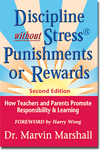|
 |
| Teachers.Net Gazette Vol.5 No.9 | September 2008 |
Subscribe for free home delivery |
|
Using a Butterfly Analogy to Explain the Hierarchy of Social Development The life stages of the butterfly present parallels to the social development of humans. | |
| by Dr. Marvin Marshall www.MarvinMarshall.com Regular contributor to the Gazette September 1, 2008 |
|

The following is from a post on the YAHOO! DisciplineWithoutStress support group dedicated to discussing the Discipline Without Stress Teaching Model described at www.marvinmarshall.com/ This particular post describes how the four stages of a butterfly correlate with four stages of social development. The four stages—referred to in the above link—is the first phase of Part III (The Raise Responsibility System) and is the only teaching required to implement the system (aside from teaching procedures, which is the first part of the system). Here is the post: I began by reminding the students of their study in third grade of the life cycle of a butterfly. They recalled that there are four stages of development in the life cycle of a butterfly: egg, caterpillar, pupa, and butterfly. We talked about how all butterflies are in some stage of this process, but they have no control over their movement through this process. We then moved on to comparing the butterfly’s life cycle to that of humans. We decided that humans go through four basic stages as well. We called them: baby/infant, child/youth, adolescence/teen, and adult/grown-up. Again we agreed that humans had little control over the stage of physical development in which they found themselves. Then we began to look at the four stages of social development in which one human and/or a society could operate. We talked about what a human and a society in anarchy would look like and how such a situation was so hopeless. Then we talked about what would likely occur to remedy the problems of an anarchy-based society. We decided that someone would rise up and take control of the situation (thereby becoming a boss) and that this may or may not be a good thing. We looked at countries around the world where we thought this might have happened. Next we moved on to looking at the level of control or power in a group of friends. We decided that a group of friends works together to share control based on what they agree is their mission and that oftentimes this mission and the group control is not ever discussed; it is more or less just understood among the group members. From here a discussion of blind conformity developed and how this type of cooperation is not necessarily good. We went on to look at how being considerate of others and cooperating for the right reasons resulted in a democratic society like the United States. We decided that doing what is right because we know it is the best thing to do is a much higher level of development than doing what is right as a result of peer pressure. Finally, we talked about how we had more control over our stage of social development than we did over our stage of physical development. The thought of being in control over something about themselves heightened their interest in the Raise Responsibility System. The important part of the hierarchy is having students reflect on their motivation—Level C, external motivation, or Level D, internal motivation. The more students reflect on their level of motivation, the more they want to get to the highest level.
Additional information is available at Copyright © 2008 Marvin Marshall.
| |
|


 His approach is the only system that is proactive, totally noncoercive, and does not use external manipulatives or threats. He INDUCES students to WANT to act responsibly and WANT to put forth effort to learn.
His approach is the only system that is proactive, totally noncoercive, and does not use external manipulatives or threats. He INDUCES students to WANT to act responsibly and WANT to put forth effort to learn.
